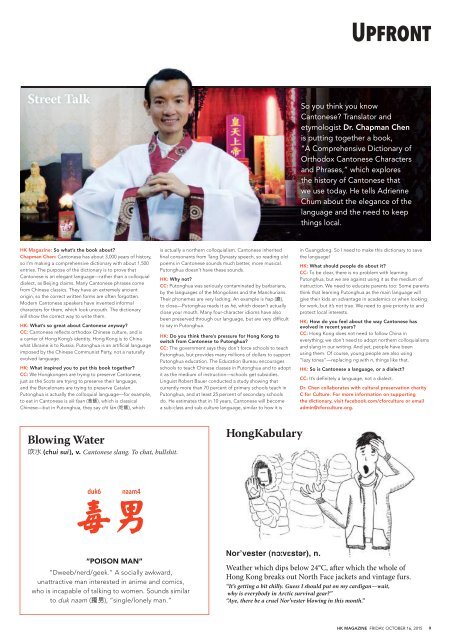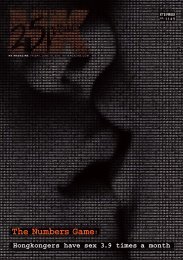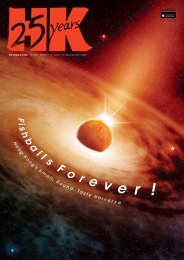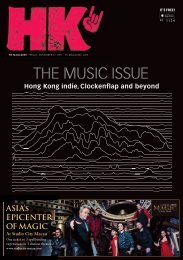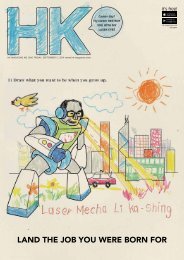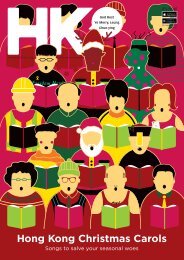Is Hong Kong about to implode?
eHzug7N
eHzug7N
Create successful ePaper yourself
Turn your PDF publications into a flip-book with our unique Google optimized e-Paper software.
Upfront<br />
Street Talk<br />
So you think you know<br />
Can<strong>to</strong>nese? Transla<strong>to</strong>r and<br />
etymologist Dr. Chapman Chen<br />
is putting <strong>to</strong>gether a book,<br />
“A Comprehensive Dictionary of<br />
Orthodox Can<strong>to</strong>nese Characters<br />
and Phrases,” which explores<br />
the his<strong>to</strong>ry of Can<strong>to</strong>nese that<br />
we use <strong>to</strong>day. He tells Adrienne<br />
Chum <strong>about</strong> the elegance of the<br />
language and the need <strong>to</strong> keep<br />
things local.<br />
HK Magazine: So what’s the book <strong>about</strong>?<br />
Chapman Chen: Can<strong>to</strong>nese has <strong>about</strong> 3,000 years of his<strong>to</strong>ry,<br />
so I’m making a comprehensive dictionary with <strong>about</strong> 1,500<br />
entries. The purpose of the dictionary is <strong>to</strong> prove that<br />
Can<strong>to</strong>nese is an elegant language—rather than a colloquial<br />
dialect, as Beijing claims. Many Can<strong>to</strong>nese phrases come<br />
from Chinese classics. They have an extremely ancient<br />
origin, so the correct written forms are often forgotten.<br />
Modern Can<strong>to</strong>nese speakers have invented informal<br />
characters for them, which look uncouth. The dictionary<br />
will show the correct way <strong>to</strong> write them.<br />
HK: What’s so great <strong>about</strong> Can<strong>to</strong>nese anyway?<br />
CC: Can<strong>to</strong>nese reflects orthodox Chinese culture, and is<br />
a carrier of <strong>Hong</strong> <strong>Kong</strong>’s identity. <strong>Hong</strong> <strong>Kong</strong> is <strong>to</strong> China<br />
what Ukraine is <strong>to</strong> Russia. Pu<strong>to</strong>nghua is an artificial language<br />
imposed by the Chinese Communist Party, not a naturally<br />
evolved language.<br />
HK: What inspired you <strong>to</strong> put this book <strong>to</strong>gether?<br />
CC: We <strong>Hong</strong>kongers are trying <strong>to</strong> preserve Can<strong>to</strong>nese,<br />
just as the Scots are trying <strong>to</strong> preserve their language,<br />
and the Barcelonans are trying <strong>to</strong> preserve Catalan.<br />
Pu<strong>to</strong>nghua is actually the colloquial language—for example,<br />
<strong>to</strong> eat in Can<strong>to</strong>nese is sik faan ( 食 飯 ), which is classical<br />
Chinese—but in Pu<strong>to</strong>nghua, they say chī fàn ( 吃 飯 ), which<br />
is actually a northern colloquialism. Can<strong>to</strong>nese inherited<br />
final consonants from Tang Dynasty speech, so reading old<br />
poems in Can<strong>to</strong>nese sounds much better, more musical.<br />
Pu<strong>to</strong>nghua doesn’t have these sounds.<br />
HK: Why not?<br />
CC: Pu<strong>to</strong>nghua was seriously contaminated by barbarians,<br />
by the languages of the Mongolians and the Manchurians.<br />
Their phonemes are very lacking. An example is hap ( 盍 ),<br />
<strong>to</strong> close—Pu<strong>to</strong>nghua reads it as hé, which doesn’t actually<br />
close your mouth. Many four-character idioms have also<br />
been preserved through our language, but are very difficult<br />
<strong>to</strong> say in Pu<strong>to</strong>nghua.<br />
HK: Do you think there’s pressure for <strong>Hong</strong> <strong>Kong</strong> <strong>to</strong><br />
switch from Can<strong>to</strong>nese <strong>to</strong> Pu<strong>to</strong>nghua?<br />
CC: The government says they don’t force schools <strong>to</strong> teach<br />
Pu<strong>to</strong>nghua, but provides many millions of dollars <strong>to</strong> support<br />
Pu<strong>to</strong>nghua education. The Education Bureau encourages<br />
schools <strong>to</strong> teach Chinese classes in Pu<strong>to</strong>nghua and <strong>to</strong> adopt<br />
it as the medium of instruction—schools get subsidies.<br />
Linguist Robert Bauer conducted a study showing that<br />
currently more than 70 percent of primary schools teach in<br />
Pu<strong>to</strong>nghua, and at least 25 percent of secondary schools<br />
do. He estimates that in 10 years, Can<strong>to</strong>nese will become<br />
a sub-class and sub-culture language, similar <strong>to</strong> how it is<br />
in Guangdong. So I need <strong>to</strong> make this dictionary <strong>to</strong> save<br />
the language!<br />
HK: What should people do <strong>about</strong> it?<br />
CC: To be clear, there is no problem with learning<br />
Pu<strong>to</strong>nghua, but we are against using it as the medium of<br />
instruction. We need <strong>to</strong> educate parents <strong>to</strong>o: Some parents<br />
think that learning Pu<strong>to</strong>nghua as the main language will<br />
give their kids an advantage in academics or when looking<br />
for work, but it’s not true. We need <strong>to</strong> give priority <strong>to</strong> and<br />
protect local interests.<br />
HK: How do you feel <strong>about</strong> the way Can<strong>to</strong>nese has<br />
evolved in recent years?<br />
CC: <strong>Hong</strong> <strong>Kong</strong> does not need <strong>to</strong> follow China in<br />
everything; we don’t need <strong>to</strong> adopt northern colloquialisms<br />
and slang in our writing. And yet, people have been<br />
using them. Of course, young people are also using<br />
“lazy <strong>to</strong>nes”—replacing ng with n, things like that.<br />
HK: So is Can<strong>to</strong>nese a language, or a dialect?<br />
CC: It’s definitely a language, not a dialect.<br />
Dr. Chen collaborates with cultural preservation charity<br />
C for Culture. For more information on supporting<br />
the dictionary, visit facebook.com/cforculture or email<br />
admin@cforculture.org.<br />
Blowing Water<br />
(chui sui ), v. Can<strong>to</strong>nese slang. To chat, bullshit.<br />
<strong>Hong</strong>Kabulary<br />
duk6<br />
naam4<br />
<br />
“POISON MAN”<br />
“Dweeb/nerd/geek.” A socially awkward,<br />
unattractive man interested in anime and comics,<br />
who is incapable of talking <strong>to</strong> women. Sounds similar<br />
<strong>to</strong> duk naam ( 獨 男 ), “single/lonely man.”<br />
Nor’vester (nɔːvɛstər), n.<br />
Weather which dips below 24°C, after which the whole of<br />
<strong>Hong</strong> <strong>Kong</strong> breaks out North Face jackets and vintage furs.<br />
“It’s getting a bit chilly. Guess I should put on my cardigan—wait,<br />
why is everybody in Arctic survival gear?”<br />
“Aye, there be a cruel Nor’vester blowing in this month.”<br />
HK MAGAZINE FRIDAY, OCTOBER 16, 2015 9


